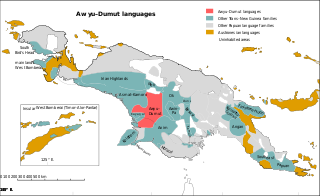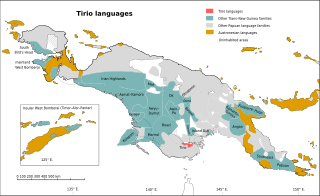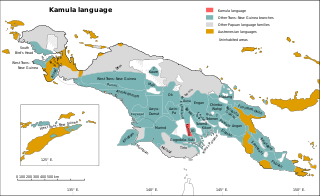Related Research Articles
The Sko or Skou languages are a small language family spoken by about 7000 people, mainly along the Vanimo coast of Sandaun Province in Papua New Guinea, with a few being inland from this area and at least one just across the border in the Indonesian province of Papua.
Indo-Pacific is a hypothetical language macrofamily proposed in 1971 by Joseph Greenberg and now believed to be spurious. It grouped together the Papuan languages of New Guinea and Melanesia with the languages of the Andaman Islands and, tentatively, the languages of Tasmania, both of which are remote from New Guinea. The valid cognates Greenberg found turned out to be reflexes of the less extensive Trans–New Guinea family. Recently the Kusunda language, which is generally seen as a language isolate, is also included in the Indo-Pacific proposal. Greenberg did not include "Australian" in his original 1971 proposal.

The Trans-Fly – Bulaka RiverakaSouth-Central Papuan languages form a hypothetical family of Papuan languages. They include many of the languages west of the Fly River in southern Papua New Guinea into southern Indonesian West Papua, plus a pair of languages on the Bulaka River a hundred km further west.

The Eastern Trans-Fly languages are a small independent family of Papuan languages spoken in the Oriomo Plateau to the west of the Fly River in New Guinea.
The Yuat languages are an independent family of five Papuan languages spoken along the Yuat River in East Sepik Province, Papua New Guinea. They are an independent family in the classification of Malcolm Ross, but are included in Stephen Wurm's Sepik–Ramu proposal. However, Foley and Ross could find no lexical or morphological evidence that they are related to the Sepik or Ramu languages.
The Karkar language, also known as Yuri, is the sole Eastern Pauwasi language of Papua New Guinea. There are about a thousand speakers along the Indonesian border spoken in Green River Rural LLG, Sandaun Province.
The Yalë language, also known as Yadë, Nagatman, or Nagatiman, is spoken in northwestern Papua New Guinea. It may be related to the Kwomtari languages, but Palmer (2018) classifies it as a language isolate.

The Greater Awyu or Digul River languages, known in earlier classifications with more limited scope as Awyu–Dumut (Awyu–Ndumut), are a family of perhaps a dozen Trans–New Guinea languages spoken in eastern West Papua in the region of the Digul River. Six of the languages are sufficiently attested for a basic description; it is not clear how many of the additional names may be separate languages.

The Tirio languages are a family of Trans–New Guinea languages in the classification of Malcolm Ross. The Tirio languages have about 40% of their lexicon in common.

The Yam languages, also known as the Morehead River languages, are a family of Papuan languages. They include many of the languages south and west of the Fly River in Papua New Guinea and Indonesian West Papua.

The Pahoturi River languages are a small family of Papuan languages spoken around the Pahoturi. This family includes eight language varieties including Agöb (Dabu), Em, Ende, Idan, Idi, Idzuwe, Kawam, and Taeme, which are spoken in the Pahoturi River area south of the Fly River, just west of the Eastern Trans-Fly languages. Idzuwe is no longer spoken. Ross (2005) tentatively includes them in the proposed Trans-Fly – Bulaka River family, though more recent work has classified Pahoturi River as an independent family within the region.
The Trans-Fly languages are a small family of Papuan languages proposed by Timothy Usher, that are spoken in the region of the Fly River.

Kamula is a Trans–New Guinea language that is unclassified within that family in the classification of Malcolm Ross (2005). Noting insufficient evidence, Pawley and Hammarström (2018) leave it as unclassified.
Keuw is an unclassified language of New Guinea.
Bine, also known as Pine, Kunini, Masingara or Oriomo, is a Papuan language of New Guinea. Glottolog lists the following varieties: Boze-Giringarede, Irupi-Drageli, Kunini, Masingle, Sebe, Sogal and Tate.
Bitur is Papuan language of Western Province, Papua New Guinea.
Oriomo may refer to:
The Sogeram languages are a family of languages in the Madang stock of New Guinea. They are named after the Sogeram River.

Oriomo-Bituri Rural LLG is a local-level government (LLG) of Western Province, Papua New Guinea. Eastern Trans-Fly languages are spoken in the LLG.
The Oriomo Plateau is a plateau in Western Province, Papua New Guinea.
References
- ↑ Wipi at Ethnologue (18th ed., 2015) (subscription required)
- ↑ Hammarström, Harald; Forkel, Robert; Haspelmath, Martin, eds. (2017). "Wipi language". Glottolog 3.0 . Jena, Germany: Max Planck Institute for the Science of Human History.
- ↑ Evans, Nicholas (2018). "The languages of Southern New Guinea". In Palmer, Bill (ed.). The Languages and Linguistics of the New Guinea Area: A Comprehensive Guide. The World of Linguistics. Vol. 4. Berlin: De Gruyter Mouton. pp. 641–774. ISBN 978-3-11-028642-7.
- ↑ Anne Dondorp and Jae-Wook Shim. 2013 [1997]. Wipi Grammar Essentials. 128pp.
- ↑ SIL; Shim, Jae-Wook (September 2000). "Wipi (Gidra, Oriomo, Jibu) Language [GDR] Daru – Western Province" (PDF). Organised Phonology Data.
{{cite journal}}: CS1 maint: multiple names: authors list (link)